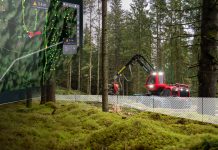Researchers at the Swiss university ETH Zurich have developed an autonomous excavator capable of constructing dry-stone walls.
The autonomous excavator, named HEAP, was recently deployed to construct a six metre-high and sixty-five-metre-long dry-stone wall. The wall is embedded in a digitally planned and autonomously excavated landscape and park.
HEAP (Hydraulic Excavator for an Autonomous Purpose) is a customized Menzi Muck M545 developed for autonomous use cases as well as advanced teleoperation.
Menzi Muck spider, or walking excavators move on four wheels connected to the undercarriage by legs. The legs allow the adjustment of track width and the height of the excavator. This ability to ‘walk’ allows the machine to travel over rough terrain or steep slopes.
The machine has novel force-controllable hydraulic cylinders in the chassis that allow it to adapt to any terrain. As well, HEAP is equipped with sensors necessary for autonomous operation, such as LIDARs, IMU, GNSS and joint sensing.
Using sensors, the excavator can autonomously draw a 3D map of the construction site and localize existing building blocks and stones for the wall’s construction.
Specifically designed tools and machine vision approaches enable the excavator to scan and grab large stones in its immediate environment. It can also register their approximate weight as well as their centre of gravity.
An algorithm determines the best position for each stone, and the excavator then conducts the task itself by placing the stones in the desired location. The autonomous machine can place 20 to 30 stones in a single consignment – about as many as one delivery could supply.
The team of researchers behind HEAP included Gramazio Kohler Research, the Robotics Systems Lab, Vision for Robotics Lab, and the Chair of Landscape Architecture.
They developed the autonomous excavator as part of the National Centre of Competence in Research for Digital Fabrication (NCCR dfab). The centre aims to revolutionize architecture through the seamless combination of digital technologies and physical building process.













